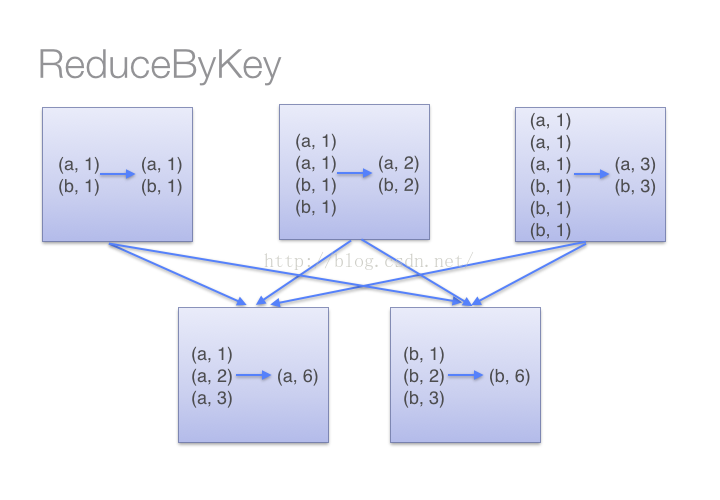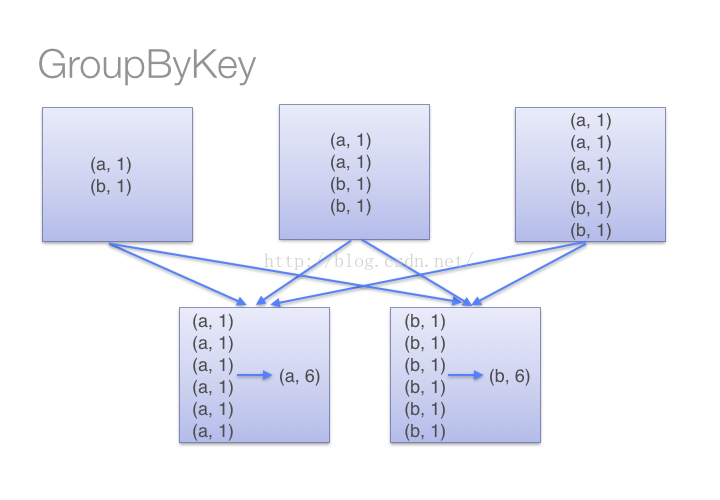2019独角兽企业重金招聘Python工程师标准>>> 
在Spar看中,我们知道一切的操作都是基于RDD的。在使用中,RDD有一种非常特殊也是非常实用的format——pair RDD,即RDD的每一行是(key, value)的格式。这种格式很像Python的字典类型,便于针对key进行一些处理。
针对pair RDD这样的特殊形式,spark中定义了许多方便的操作,今天主要介绍一下reduceByKey和groupByKey,因为在接下来讲解《在spark中如何实现SQL中的group_concat功能?》时会用到这两个operations。
首先,看一看spark官网[1]是怎么解释的:
reduceByKey(func, numPartitions=None)
Merge the values for each key using an associative reduce function. This will also perform the merging locally on each mapper before sending results to a reducer, similarly to a “combiner” in MapReduce. Output will be hash-partitioned with numPartitions partitions, or the default parallelism level if numPartitions is not specified.
也就是,reduceByKey用于对每个key对应的多个value进行merge操作,最重要的是它能够在本地先进行merge操作,并且merge操作可以通过函数自定义。
groupByKey(numPartitions=None)
Group the values for each key in the RDD into a single sequence. Hash-partitions the resulting RDD with numPartitions partitions. Note: If you are grouping in order to perform an aggregation (such as a sum or average) over each key, using reduceByKey or aggregateByKey will provide much better performance.
也就是,groupByKey也是对每个key进行操作,但只生成一个sequence。需要特别注意“Note”中的话,它告诉我们:如果需要对sequence进行aggregation操作(注意,groupByKey本身不能自定义操作函数),那么,选择reduceByKey/aggregateByKey更好。这是因为groupByKey不能自定义函数,我们需要先用groupByKey生成RDD,然后才能对此RDD通过map进行自定义函数操作。
为了更好的理解上面这段话,下面我们使用两种不同的方式去计算单词的个数[2]:
val words = Array("one", "two", "two", "three", "three", "three")
val wordPairsRDD = sc.parallelize(words).map(word => (word, 1))
val wordCountsWithReduce = wordPairsRDD.reduceByKey(_ + _)
val wordCountsWithGroup = wordPairsRDD.groupByKey().map(t => (t._1, t._2.sum)) 上面得到的wordCountsWithReduce和wordCountsWithGroup是完全一样的,但是,它们的内部运算过程是不同的。
(1)当采用reduceByKeyt时,Spark可以在每个分区移动数据之前将待输出数据与一个共用的key结合。借助下图可以理解在reduceByKey里究竟发生了什么。 注意在数据对被搬移前同一机器上同样的key是怎样被组合的(reduceByKey中的lamdba函数)。然后lamdba函数在每个区上被再次调用来将所有值reduce成一个最终结果。整个过程如下:

(2)当采用groupByKey时,由于它不接收函数,spark只能先将所有的键值对(key-value pair)都移动,这样的后果是集群节点之间的开销很大,导致传输延时。整个过程如下:

因此,在对大数据进行复杂计算时,reduceByKey优于groupByKey。
另外,如果仅仅是group处理,那么以下函数应该优先于 groupByKey :
(1)、combineByKey 组合数据,但是组合之后的数据类型与输入时值的类型不一样。
(2)、foldByKey合并每一个 key 的所有值,在级联函数和“零值”中使用。
最后,对reduceByKey中的func做一些介绍:
如果是用python写的spark,那么有一个库非常实用:operator[3],其中可以用的函数包括:大小比较函数,逻辑操作函数,数学运算函数,序列操作函数等等。这些函数可以直接通过“from operator import *”进行调用,直接把函数名作为参数传递给reduceByKey即可。如下:
<span style="font-size:14px;">from operator import add
rdd = sc.parallelize([("a", 1), ("b", 1), ("a", 1)])
sorted(rdd.reduceByKey(add).collect()) [('a', 2), ('b', 1)]</span>
)




![bzoj1088[SCOI2005]扫雷Mine](http://pic.xiahunao.cn/bzoj1088[SCOI2005]扫雷Mine)




)








![整理ASP.NET MVC 5各种错误请求[401,403,404,500]的拦截及自定义页面处理实例](http://pic.xiahunao.cn/整理ASP.NET MVC 5各种错误请求[401,403,404,500]的拦截及自定义页面处理实例)